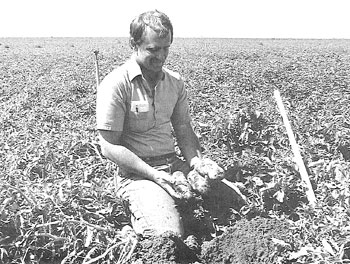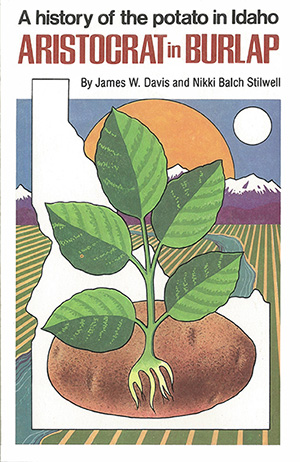 Mark Noble, Farm Development Corporation manager at Grindstone Butte and Sailor Creek, checks a hill of Shepody potatoes grown for a processor under contract. Potatoes are now grown in a long rotation cycle but still produce high yields after 20 years of farming the desert entry land.
Mark Noble, Farm Development Corporation manager at Grindstone Butte and Sailor Creek, checks a hill of Shepody potatoes grown for a processor under contract. Potatoes are now grown in a long rotation cycle but still produce high yields after 20 years of farming the desert entry land.
Since corporations were not allowed under the law to file on desert entry land, when two of the state's largest food processors decided to develop high-lift pumping projects, it was necessary for them to find tracts of deeded land that could be purchased and put under irrigation. The J. R. Simplot Company acquired an area above the Payette River where they reclaimed 2,500 acres of desert land with a 440-foot water lift. Ore-Ida Foods, a division of the H. J. Heinz Company, crossed the state line into Oregon and developed Skyline Farms in Malheur County. Both projects were similar in concept to the Snake River projects, but neither seemed blessed with the fertile soil that the entrymen found at Sailor Creek and Bell Rapids.
As a result, both Payette Farms and Skyline Farms met with indifferent success for their corporate developers as far as agricultural productivity was concerned. The Simplot Company converted the Payette Farm Company to orchards for the growing of apples and purchased Skyline Farms from the H. J. Heinz Company, only to sell it again to finally become the site for a new Oregon state prison.
The 15-year period of high-lift irrigation development in Idaho saw an era of history develop in a unique and interesting way. Government-sponsored and financed reclamation projects were responsible for most of the large acreage land reclamation in the early days. After the development of the Bureau of Reclamation projects, the next growth increment came primarily from areas of desert that were irrigated from deep wells with pumping from the huge aquifer that underlies the Snake River drainage. The nature of the land and the cost of well drilling limited this type of reclamation to individual projects, which never reached the spectacular size of the ones developed by pumping water from the Snake River itself. With private financing replacing large expenditures of federal money, these most recent reclamation projects were brought into production without involving the United States taxpayer.
Two financial institutions contributed greatly to land development along the Snake River. They were the Idaho First National Bank (now US Bank) and the Northwest Mutual Insurance Company. Typical financial arrangements involved Northwest Mutual lending entrymen the long-term money for the development of the project, and Idaho First National making the short-term loans to individual entrymen for the development of their tracts.


 Mark Noble, Farm Development Corporation manager at Grindstone Butte and Sailor Creek, checks a hill of Shepody potatoes grown for a processor under contract. Potatoes are now grown in a long rotation cycle but still produce high yields after 20 years of farming the desert entry land.
Mark Noble, Farm Development Corporation manager at Grindstone Butte and Sailor Creek, checks a hill of Shepody potatoes grown for a processor under contract. Potatoes are now grown in a long rotation cycle but still produce high yields after 20 years of farming the desert entry land.